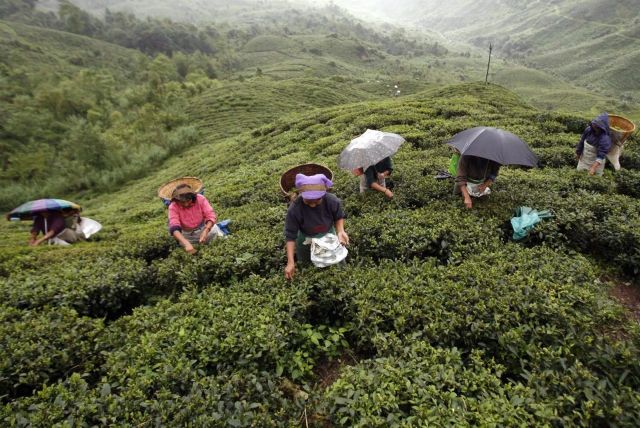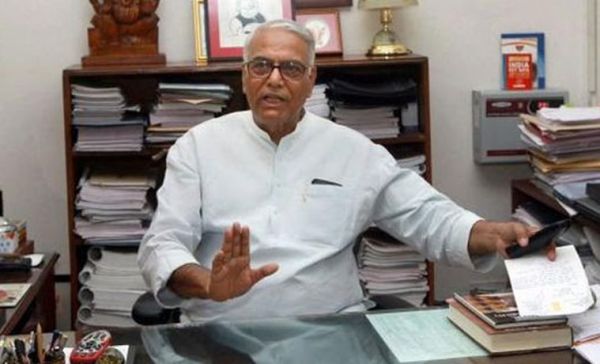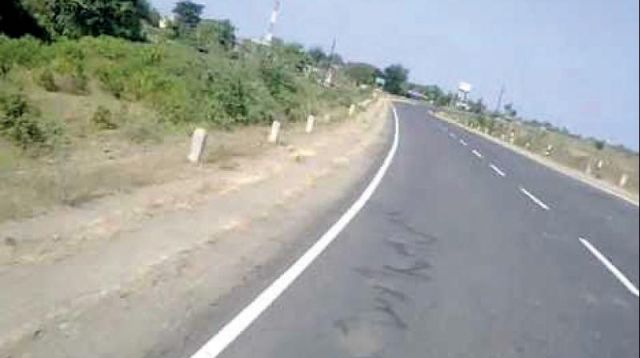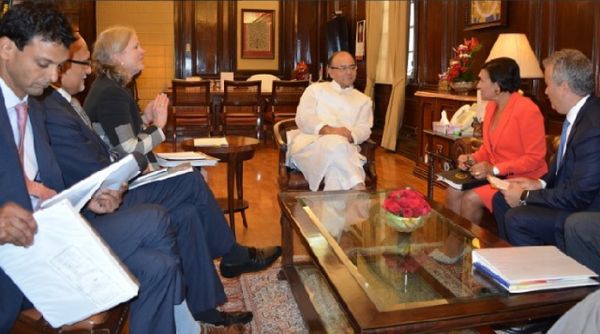
by admin | May 25, 2021 | Corporate Jobs, Employment, News, Private Jobs
 Kolkata : Despite the withdrawal of a shutdown in the Bengal hills, nearly 60 per cent the workers are yet to resume work at the Darjeeling tea gardens, industry officials said on Sunday.
Kolkata : Despite the withdrawal of a shutdown in the Bengal hills, nearly 60 per cent the workers are yet to resume work at the Darjeeling tea gardens, industry officials said on Sunday.
“About 60 per cent of around one lakh workers of the Darjeeling tea industry have not joined work even after the withdrawal of the shutdown,” Darjeeling Tea Association’s Chairman Binod Mohan told IANS.
According to him, the prolonged shutdown might have forced the workforce to venture out of the hills and seek alternate jobs.
“Hopefully, they will come back soon and join work,” he said adding that the annual tea production had been “affected severely” this year and the only thing required to be done is “clearing the jungle” that has grown during the strike.
“There was no work at Darjeeling tea gardens for over 100 days. A significant part of the workforce migrated to other places for alternative jobs. The situation in Darjeeling still remains fragile. It seems workers who got some earning sources outside are taking their time to return,” said Centre of Indian Trade Unions’ General Secretary (tea industry) Zia- Ul-Alam, also convener of Joint Forum of Trade Unions, an umbrella organisation of trade unions working in tea sector.
All stakeholders, including all political parties in the hills, Centre and state government and tea industry players must sit together to build confidence among workers, he said.
Mohan said the tea industry has started making bonus payments to the workers.
After a recent tripartite meeting between workers’ unions, tea garden owners and the government, it was decided the bonus to workers would be paid at 19.75 per cent of the annual wage earnings for the financial year 2016-17.
Due to the shutdown, all plucking and manufacturing operations in the 87 gardens in Darjeeling was suspended and there was no second flush production, considered premium variety contributing to about 20 per cent of the annual industry production and accounting for approximately 40 per cent of the annual revenue, Mohan said.
The industry sought a Rs 230 crore-Rs 240 crore financial support from the government, he added.
—IANS

by admin | May 25, 2021 | Employment, Interviews

Yashwant Sinha
By V.S. Chandrasekar and Meghna Mittal,
New Delhi : Dissident BJP leader Yashwant Sinha remains unfazed by all the criticism he has faced for his strong critique of the economy and asserts that lack of jobs will be a major issue in the next Lok Sabha elections.
He also feels any attempt at polarising voters on issues like the Ram temple or Article 370 of the Constitution will not work on a country-wide basis.
On demonetisation, which he has been strongly critical of, Sinha says he would have opposed it “tooth and nail” had he been the Finance Minister.
“I feel vindicated (on the Indian Express article attacking the government’s handling of the economy). My first satisfaction is that the issue is being debated. There is quite an informed debate going on. I stand by the facts and figures I quoted. I see no signs so far of a respite for the stressed sectors of our economy.
“RBI has not revised rates. On the fiscal side again, the indications are that even if they don’t go for fiscal expansion, the target of fiscal deficit will be breached the way expenditure is happening this year,” Sinha told IANS in an interview.
Sinha said he made a point on the economy and it was his assessment — and there can be a differing point of view. “But they (government) have not answered a single issue. Out of the council of ministers, my son (Civil Aviation Minister Jayant Sinha) has come out. People said it should be dismissed as a father-son feud. It was reducing it to the level of such flippancy that the serious issue would be lost. I am happy that it has not.”
Asked about whether the BJP would find the going tough in the 2019 Lok Sabha elections and if the ruling party would attempt to polarise votes on issues like the Ram temple, uniform civil code and Article 370, the BJP veteran said it was too early to answer that question as there are about 18 months still left.
“The Indian voter is unpredictable and I should know given the 2004 elections,” he said in a reference to the defeat suffered by his party then after it advanced the polls on the “Shining India” campaign. “New India” is the slogan now, he added.
He said there are two issues in the economy. “One is jobs and (the other) price rise. The Indian voter is worried if my lad has a job or not. That adds to frustration. As far as employment is concerned, it will be a major issue. Household after household will be suffering from unemployment.”
On the question of polarisation, Sinha said, “That kind of polarisation has never worked on a country-wide basis. It may in pockets, but I don’t think it will meet with electoral success. One thing is very certain. Either it (temple construction) will have to be with the consent of the parties concerned or through a court judgement. You will succeed only if there is a conflicting environment. Then only polarisation will take place. And it does not work every time. ”
Admitting that the only good thing about the Modi government is that so far there have been no corruption charges, Sinha said the common man however does not benefit from it. He benefits from cutting-edge administration. “Nothing has changed on that front. For the common man, there is hardly any relief.”
Sinha said there was no clear policy emerging on how to tackle the distress in various sectors. He referred to the way the share market was behaving and called it a case for study. RBI has said it will prevent volatility from market.
“There is a camp which says that rupee should be allowed to depreciate because it is affecting exports. We don’t see any clear policy emerging.
“From the economic point of view, exports have come down, foreign demand is not there. Industrial demand is not there. Overall demand in the economy is not there. That is one reason why private investment is not taking place. There is no generation of fresh capacity. This is serious… because economic growth will take place only on the basis of rising demand. In 3.5 years of this government, there is no demand.”
On demonetisation, Sinha said he would have opposed it tooth and nail had he been the Finance Minister. “It is a long debate what demonetisation can achieve, what it has achieved and what can be achieved through alternative means.
“We are talking of cashless. We have a whole host of measures to go cashless. I think there are 1.8 million cases (of disproportionate deposits). And all these cases will take their own time. If the Income Tax department has to handle these cases, then tax terrorism has returned. We are declaring to the world we are a country of thieves and black money holders.
“By when will we see the outcome of these cases, we don’t know. The fact of the matter is that they have blundered badly as far as this move of demonetisation is concerned.”
To a question on the Goods and Services Tax (GST) and the problems encountered by traders on account of its implementation, he said, “Now suddenly it has become the biggest reform since 1947 and they are tom-tomming it. I am seriously questioning the understanding of taxation that these people possess. Fifteen years (after) I introduced CENVAT with three rates, they introduce GST with five official rates — and with many more cesses. There can’t be more than three rates.”
Sinha said that demand needs to be created and there was need to create an investment for demand for goods first in the economy. “We have to create demand for investment goods. That will lead to more job opportunities, money will flow into people’s pockets through employment and then demand for consumption goods will rise. But this is not happening now.”
(V.S. Chandrasekar and Meghna Mittal can be contacted at chandru.v@ians.in and meghna.m@ians.in)
—IANS

by admin | May 25, 2021 | Corporate Jobs, Employment, Government Jobs, News, Private Jobs
 Mumbai : Nearly 150,000 direct and indirect jobs in India’s debt-ridden and loss-making telecom sector face “clear and present danger” of corporate downsizing, as per estimates by industry sources.
Mumbai : Nearly 150,000 direct and indirect jobs in India’s debt-ridden and loss-making telecom sector face “clear and present danger” of corporate downsizing, as per estimates by industry sources.
At present, the sector is burdened with astronomical debt — to the tune of nearly Rs 8 lakh crore by some estimates — and heavy losses due to a slew of freebies which are being doled out by incumbent telecom players to retain their customer base.
The grim reality that the sector faces can be gauged by the comments made by Communications Minister Manoj Sinha at the recently held India Mobile Congress: “The government is aware of the stress in the sector… earlier also we have intervened, and if needed we will do so again.”
“We will make sure that the sector does not die,” said the minister.
In April, the Reserve Bank of India (RBI) had also cautioned commercial banks about loans given to companies in the telecom sector.
“The telecom sector is reporting stressed financial conditions, and presently interest coverage ratio for the sector is less than one,” the RBI note had said.
According to industry observers, telecom companies have no option left but to initiate “severe cost-cutting” measures — including downsizing — to sustain operations.
Facing the axe are between 20,000-25,000 direct jobs, many of which will be due to planned mergers between incumbent players. Mergers alone will lead to over 15,000 job losses as existing portfolios and profiles are duplicated.
As per industry sources, major player Idea Cellular has axed around 1,800 jobs in the lead-up to its planned merger with Vodafone. A further reduction of 5,000-6,000 employees is on the cards as and when the merger fructifies, perhaps next March.
On the other hand, Vodafone has laid-off 1,400 people from its side as part of the merger plans with Idea, the sources said.
Although industry sources pointed towards job losses in telecom major Bharti Airtel, the company has denied the same.
Reliance Communications has also laid off some 1,200 people over the last year in the lead-up to the merger with Sistema and its now-called-off merger with Aircel, which, too, is learnt to have let go of 800 employees, estimates show.
However, industry estimates place a far larger number of around 125,000 indirect jobs that will be wiped out due to the turbulence being faced by the sector.
“In the larger scheme of things, with the economy slowing down and most industry sectors seeing flat or negative growth, the impact is going to be ‘telling and bloody’, with jobs not being created across sectors, and re-employment becoming a tough task,” an industry analyst told IANS.
Besides the sector, the Union government, which has come under criticism from various quarters for slow economic growth and lower-than-expected job creation, will also find it hard to provide substantial alternative opportunities to the unemployed.
Till some time back, the sector was amongst the top five largest employment opportunity generators in the country. It supported direct employment of over 20 lakh in the country during 2015-16.
“As per some estimates, the mobile industry in India currently contributes 6.5 per cent ($140 billion) to the country’s GDP, and employs over four million people (direct and indirect),” said the Annual Report 2016-17 of the Department of Telecommunications.
—IANS

by admin | May 25, 2021 | Employment, Government Jobs, News
 New Delhi : The National Highway Authority of India’s (NHAI) ongoing and targeted projects would generate employment of around 50 crore man-days over the next four years, an official statement said on Friday.
New Delhi : The National Highway Authority of India’s (NHAI) ongoing and targeted projects would generate employment of around 50 crore man-days over the next four years, an official statement said on Friday.
“This would be averaging to nearly 12.5 crore man-days yearly from 2018-2022. Of this, about one crore will be professional man-days, 3.5 crore skilled labour man-days and eight crore semi-skilled and un-skilled man days,” the Road, Transport and Highways Ministry statement said.
The NHAI currently has 282 projects having length of about 20,000 km under implementation across the country out of which 10,000 kms is targeted to be completed over next one to two years, it said.
“There are around 220 projects having length of about 31,000 km which are targeted to be awarded and completed in the next three to four years across all the states in the country under National Highways Development Project and Bharat Mala Schemes.
“Thus, NHAI plans to construct approximately 50,000 km highways in next four years,” it added.
“This will generate seasonal employment opportunities as successful and efficient execution of projects invariably requires qualified professionals, skilled and semi-skilled work force.”
—IANS

by admin | May 25, 2021 | Employment, Government Jobs, News, Politics, Private Jobs

Arun Jaitley
New Delhi : The Union Cabinet on Wednesday decided to merge into five entities all the 17 government printing presses across the country without causing any job losses.
The decision about the “merger and modernization” of the “underworked” printing presses was taken in a Cabinet meeting chaired by Prime Minister Narendra Modi here.
Finance Minister Arun Jaitley said the move would enable the government to take some 468 acres of land into the central pool.
He said surplus employees at any printing press would be “redeployed”.
“All the jobs will be protected,” the Minister said.
These printing presses are located in Delhi, Haryana, Himachal Pradesh, Uttar Pradesh, Gujarat, Kerala, West Bengal, Chandigarh, Odisha and Karnataka.
—IANS

 Kolkata : Despite the withdrawal of a shutdown in the Bengal hills, nearly 60 per cent the workers are yet to resume work at the Darjeeling tea gardens, industry officials said on Sunday.
Kolkata : Despite the withdrawal of a shutdown in the Bengal hills, nearly 60 per cent the workers are yet to resume work at the Darjeeling tea gardens, industry officials said on Sunday.



